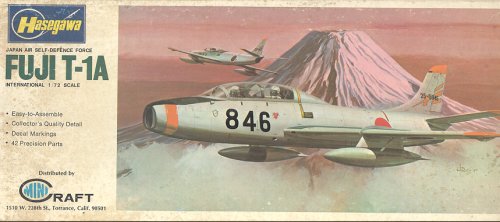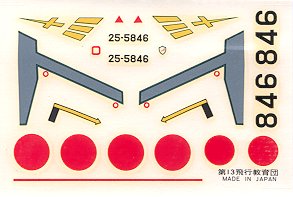
| KIT: | Hasegawa 1/72 Fuji T-1A* |
| KIT # | JS-058 |
| PRICE: | $1.30 when new (back before some of you were born) |
| DECALS: | One option |
| REVIEWER: | Scott Van Aken |
| NOTES: |

| HISTORY |
First flying in 1958, it soon entered squadron service providing many students their first fast jet experience. It was usually unarmed but able to carry two gun pods, two Sidewinders or four air to surface missiles. It could also carry a single .50 calibre machine gun. This allowed the aircraft to be able to be used as a gunnery or tactical trainer and in severe cases of emergency, it could be outfitted to carry out combat missions. It has been replaced in service by the T-4, the last T-1A being retired in the late 1980s or early 1990s.
| THE KIT |

This kit would rank up there with some of the first batch of Hasegawa kits ever produced. Hasegawa initially did models of aircraft that were being used by the JASDF, so that is why you see their very early kits being the T-33, F-86, T-34 and so on. This one falls into that category and is pretty well unique to Hasegawa. No one else that I am aware of has deigned to try to kit this particular aircraft.
As a child of its times, it does have finely raised detail, but no rivets. There is minimal detail in the cockpit which consists of a flat floor, two ejection seat shapes and two crew members, whose inclusion is meant to disguise the fact that there is nothing else there. There are two drop tanks as the only possible option to the kit. In the few photos I have of this plane, these seem to be a pretty well permanent attachment. Gear bays are there, but with no real detail. The nose wheel is molded with the gear and the main wheels seem just a touch toy-like. There is a two piece canopy so that you can pose the aft section open, but no actuating arm or any other real detail in there. A nice plus is that this kit is free from flash and sink areas. There are a few ejector pin bits on the gear, but nothing major and totally typical of even new Hasegawa kits.
 Instructions are not what we currently expect from Hasegawa, but for the time, they were more than adequate. There are five construction steps and one painting section. Color information for the entire kit is given there in generic colors. These call for the plane to be painted a gloss white with dayglo orange panels. These aircraft were also in bare metal with similar markings. There is only one aircraft provided on the rather old and thick decals. While the instructions would have you believe that there are marking for the test unit, no markings are included. it is a good thing that old Hasegawa decals tend to work rather well as there are no aftermarket options! I should also mention that it wouldn't be a bad idea to add a touch of weight, though the instructions do not indicate that it is needed.
Instructions are not what we currently expect from Hasegawa, but for the time, they were more than adequate. There are five construction steps and one painting section. Color information for the entire kit is given there in generic colors. These call for the plane to be painted a gloss white with dayglo orange panels. These aircraft were also in bare metal with similar markings. There is only one aircraft provided on the rather old and thick decals. While the instructions would have you believe that there are marking for the test unit, no markings are included. it is a good thing that old Hasegawa decals tend to work rather well as there are no aftermarket options! I should also mention that it wouldn't be a bad idea to add a touch of weight, though the instructions do not indicate that it is needed.
| CONCLUSIONS |
This isn't a kit that one sees built very often. In fact, before the current 'Hacks and Trainers' contest entry, I'd never seen one built up other than in the Hasegawa Catalogue! Thanks to the few parts that this one has, building it should be a relatively quick prospect.
If you would like your product reviewed fairly and fairly quickly by asite that has nearly 250,000 visitors a month, please contactme or see other details in the